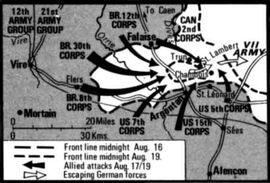The Falaise Gap was a major campaign setting in Call of Duty 3.
Overview[]
The Falaise Gap is first shown in Call of Duty 3 while fighting in four Allied campaigns. When the other Allies pushed in from North, the Nazis fell back toward Falaise Gap. To prevent them from escaping, the Americans went to Falaise Gap, and the Nazis started pouring in. As the Nazis were trapped in Falaise Gap, they finally surrendered, ending one of the bloodiest battles in the history - the battle of Normandy.
Campaign[]
After D-Day, the Americans had to hold the beaches there in order to justify the heroism there. After making a counterattack at St. Lo on July 19, the US troops advanced from the south, while British, Canadians, and Polish advanced from the northeast, forming the Falaise Gap. The US 29th Infantry Division was folded into the 90th Infantry Division in order to take over St. Germain, which was filled with hedgerows and German troops. The US Army took over the town on July 26, followed by a British raid on Toucy that revealed the location of a German Fuel Plant. By July 29, US general George S. Patton had advanced deep into Normandy. He sent the 29th Infantry Division to destroy the anti-tank bombs placed on the Mayenne Bridge so that way his armor could move up. The US troops seized Mayenne, and disarmed the bombs. On August 1, the Canadians launched Operation Totalize, seizing the city of Tilly la Champagne, whose industrial yard was used by Germans as a command base. The Canadians bottlenecked the German armor into heading down one route, and when they arrived, the Canadians destroyed them. This allowed the Polish 1st Armored Division to move, but they faced General Richter and his German tanks. They had to rely on the British SAS to cut off his supply line by seizing the fuel plant at Autun on August 9th, and they did so, despite the loss of Gerald Ingram, their commanding officer. But now, Richter could not supply his tanks with fuel. The Polish made an armored offensive through St. Aignan de-Cramesnil and Richter was killed by Polish tanker Bohater Wojciech. Two days later, a US army defeated the Germans in close combat in the Foret d'Ecouves, which was mistakenly reported to have been cleared by the French. The US advance continued, but they were being shelled by German Nebelwerfer fire coming from the Laison River. The Canadians made their move and aided the Americans by capturing the German positions there, while the Polish took Hill 262 after taking Vimoutiers. The US were able to advance to Le-Bourg-St. Leonard, which they captured. After that, they received orders to take Chambois, where the Germans were retreating. The British, in the meantime, took Les Ormes on August 20th, trying to free Maj. Ingram and several French prisoners. The same day, the Canadians took St. Lambert-sur-Dives in order to rescue a tank crew and to get reinforcements to the Polish at Hill 262, which came under attack as well. Despite dreadful losses, the Polish managed to hold until Canadians came to their relief. This left Chambois as the last route of escape for the Germans. The US troops held Chambois, killing or capturing every last German in the Falaise Gap, bringing the Normandy Campaign to an end.

The Falaise Gap
